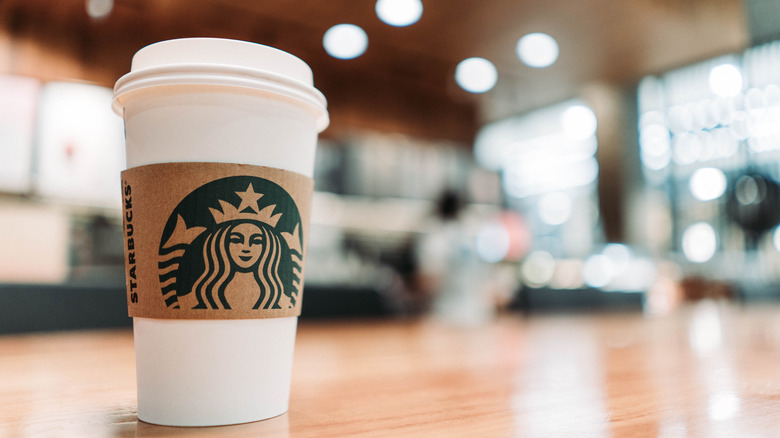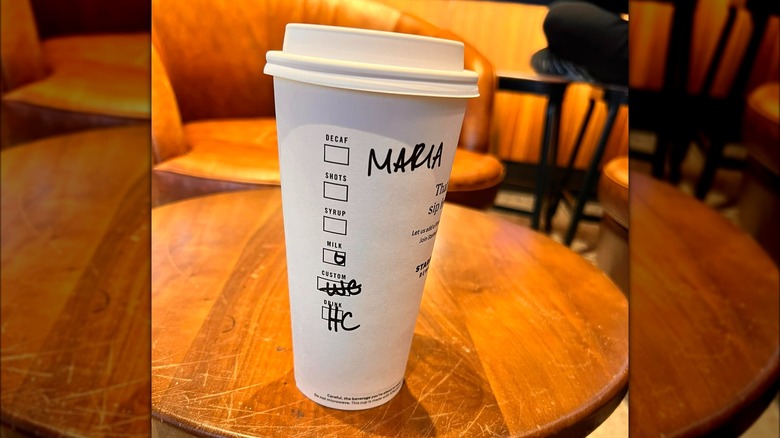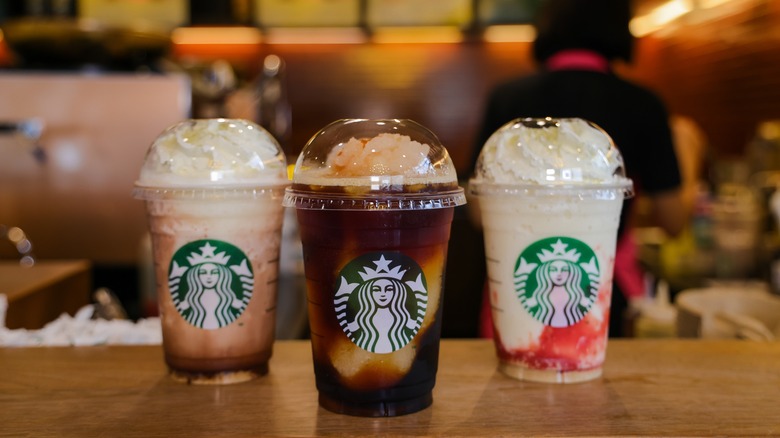Why Starbucks Baristas Write The Letter B On Your Cup
Have you ever noticed the little boxes on the side of your Starbucks cup? On the chain's classic paper cups, you'll find check boxes labeled "syrup," "milk," and more. Just as the café employees use a drink ordering code, they check off these boxes to form a drink ID code, which ensures you get exactly what you asked for, especially if the person taking your order isn't the same one who makes your drink.
While some of the terms written on your cup are self-explanatory, such as when a barista writes your name or scrawls an N for nonfat milk or S for soy milk, other notations can be confusing. One perplexing symbol is a "B" written in the milk box. A capital B signals to the barista that you've requested half-and-half (also called breve) in place of milk. Breve is Italian for "short" or "brief," and refers to how a set amount of steamed half-and-half takes up less volume than the same amount of steamed milk. This is because the high fat content in breve won't foam up and expand the same way that lower-fat milk does.
Starbucks cups also feature boxes for "decaf," "shots," "syrup," "custom," and "drink." The "syrup" box may also have a short ID code written in it if you've made a special request, like the letter C for caramel or WM for white chocolate mocha syrup. Meanwhile, the notation LT in the "custom" box signals light ice, syrup, etc.
What are the longer codes on Starbucks cups?
In addition to the one- or two letter-codes written on your Starbucks cup, you might notice longer ones written in the "drink" box. Often consisting of three or four letters, these longer codes refer to specific drinks. A Double Chocolate Chip Frappuccino, for example, will be abbreviated as DCCF, while a steamed cider will be noted as SCID. If you've ordered a regular menu item without any customizations, writing the drink's ID code lets other baristas know they don't need to make any special substitutions.
Likewise, if you've ordered a secret menu drink or something of your own creation, but it builds off an existing drink, a drink ID code can help unfamiliar baristas know where to start. For instance, when you order a pumpkin spice hot chocolate by asking for a custom drink, the barista taking your order might write HC for hot chocolate in the drink box, letting their coworker know what forms the drink's base. They can then add the codes PSS (pumpkin spice sauce), MO (mocha syrup), and/or WC (whipped cream) to the customizations box. Consider these codes to be instructions for how baristas make your drink.
Starbucks takes its notations digital
If you've never seen handwritten notes on your cup from your usual Starbucks location, it may be because the store has shifted to digital notations. Many locations made the shift to computer-generated label stickers in 2016. Especially with the rise of mobile ordering, it's easier for baristas to automatically print requests and attach them to the cup, with no need to spend time writing down a bunch of codes. Uniformly printed stickers are also easier for other baristas to read — we all know somebody who has illegible, chicken-scratch writing.
Printing out order labels also makes running the entire store more convenient. For instance, a mobile order could be transcribed onto a printed sticker, simultaneously taking into account standardized pricing and updating a digital inventory record. Those three pumps of pumpkin spice sauce are now appropriately and consistently charged, as well as tallied among the store's supply usage. As a result, the store (and corporate) can keep better track of what's selling, who's buying, and when certain items need to be replaced, all without doing a manual review. Sure, it can all feel very impersonal because of all the technology involved, but in reality, keeping track of customer trends will aid Starbucks in improving the customer experience.



